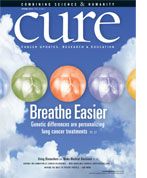Publication
Article
CURE
Choosing Quality Care
Author(s):
Q: Is it possible that we can do too much when we diagnose and treat cancer?
A: Without question, there is a lot of science behind the practice of medicine. And there is also a lot of art. Seasoned health professionals know that medical care is not one size fits all. Still, science helps us know what works and what doesn’t work. Maybe we don’t have good research for every circumstance in cancer care, but we do have enough that we need to consider the evidence before we plow ahead and assume that just because a new treatment or device exists, it will necessarily improve the care of people with cancer.
Years ago, we used regular bone scans to follow women who were asymptomatic after primary treatment for breast cancer. We believed that catching a recurrence before the patient was aware of it would lead to earlier treatment and better outcomes. We were wrong. Science showed us the scans didn’t make a difference. Eventually we stopped doing this unnecessary test.
Now, research shows us that other tests and treatments don’t always make a difference in outcomes for many patients. So, doing them just because we can doesn’t make a lot of sense. As a result, medical and consumer organizations have developed the Choosing Wisely campaign (ChoosingWisely.org) to encourage discussions between patients and their physicians, so together they can select care that is evidence-based and truly necessary.
For example, performing routine imaging scans in staging breast and prostate cancer patients with early-stage disease at low risk of spread is discouraged for a number of reasons, including unnecessary radiation exposure. Ditto on following asymptomatic breast cancer patients with surveillance imaging scans after curative treatment.
Clearly, patients need to have careful and thoughtful discussions with their doctors about which tests and treatments are best for them.
Technology is wonderful, but it must be used with respect for what it can do—and what it cannot.






